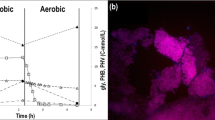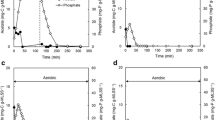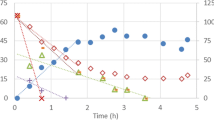Abstract
Sulphate-rich wastewaters can be generated due to (i) use of saline water as secondary-quality water for sanitation in urban environments (e.g. toilet flushing), (ii) discharge of industrial effluents, (iii) sea and brackish water infiltration into the sewage and (iv) use of chemicals, which contain sulphate, in drinking water production. In the presence of an electron donor and absence of oxygen or nitrate, sulphate can be reduced to sulphide. Sulphide can inhibit microbial processes in biological wastewater treatment systems. The objective of the present study was to assess the effects of sulphide concentration on the anaerobic and aerobic physiology of polyphosphate-accumulating organisms (PAOs). For this purpose, a PAO culture, dominated by Candidatus Accumulibacter phosphatis clade I (PAO I), was enriched in a sequencing batch reactor (SBR) fed with acetate and propionate. To assess the direct inhibition effects and their reversibility, a series of batch activity tests were conducted during and after the exposure of a PAO I culture to different sulphide concentrations. Sulphide affected each physiological process of PAO I in a different manner. At 189 mg TS-S/L, volatile fatty acid uptake was 55% slower and the phosphate release due to anaerobic maintenance increased from 8 to 18 mg PO4-P/g VSS/h. Up to 8 mg H2S-S/L, the decrease in aerobic phosphorus uptake rate was reversible (Ic60). At higher concentrations of sulphide, potassium (>16 mg H2S-S/L) and phosphate (>36 mg H2S-S/L) were released under aerobic conditions. Ammonia uptake, an indicator of microbial growth, was not observed at any sulphide concentration. This study provides new insights into the potential failure of enhanced biological phosphorus removal sewage plants receiving sulphate- or sulphide-rich wastewaters when sulphide concentrations exceed 8 mg H2S-S/L, as PAO I could be potentially inhibited.





Similar content being viewed by others
References
Amman RI (1995) In situ identification of micro-organisms by whole cell hybridization with rRNA-targeted nucleic acid probes. In: Ackkermans A, van Elsas J, de Bruijn F (eds) Molecular microbial ecology manual. Klower Academy Publications, Dordrecht, Holland
APHA, AWWA, WEF (2005) Standard methods for the examination of water and wastewater, 22th edn. American Water Works Assn
Barat R, Montoya T, Seco A, Ferrer J (2005) The role of potassium, magnesium and calcium in the Enhanced Biological Phosphorus Removal treatment plants. Env tech 26(9):983–992
Bejarano Ortiz DI, Thalasso F, Cuervo López FDM, Texier AC (2013) Inhibitory effect of sulfide on the nitrifying respiratory process. Journal of Chem Tech and Bio 88:1344–1349 (October 2012)
Bratby J (2016) Coagulation and flocculation in water and wastewater treatment, 3rd edn. IWA publishing, London
Brdjanovic D, Hooijmans CM, van Loosdrecht MCM, Alaerts GJ, Heijnen JJ (1996) The dynamic effects of potassium limitation on biological phosphorus removal. WR 30(10):2323–2328
Brock J, Rhiel E, Beutler M, Salman V, Schulz-Vogt HN (2012) Unusual polyphosphate inclusions observed in a marine Beggiatoa strain. Antonie van Leeuwenhoek International Journal of Gen and Molecular Microbiology 101(2):347–357
Chen Y, Chen H, Zheng X, Mu H (2012) The impacts of silver nanoparticles and silver ions on wastewater biological phosphorous removal and the mechanisms. Journal of HM 239-240:88–94
Chen Y, Cheng JJ, Creamer KS (2008) Inhibition of anaerobic digestion process: a review. Biores Technol 99(10):4044–4064
Comeau Y, Hall K, Hancock R, Oldham W (1986) Biochemical model for enhanced biological phosphorus removal. WR. 20(12):1511–1521
Crocetti GR, Hugenholtz P, Bond PL, Schuler A, Keller J, Jenkins D, Blackall LL (2000) Identification of polyphosphate-accumulating organisms and design of 16S rRNA-directed probes for their detection and quantitation. AEM 66(3):1175–1182
Fang J, Sun PD, Xu SJ, Luo T, Lou JQ, Han JY, Song YQ (2012) Impact of Cr(VI) on P removal performance in enhanced biological phosphorus removal (EBPR) system based on the anaerobic and aerobic metabolism. BT 121:379–385
Flowers JJ, He S, Yilmaz S, Noguera DR, McMahon KD (2009) Denitrification capabilities of two biological phosphorus removal sludges dominated by different “Candidatus Accumulibacter” clades. EMr 1(6):583–588
Ginestet P, Nicol R, Holst T, Lebossé X, (2015) Evidence for sulfide associated autotrophic biological phosphorus removal in a full scale wastewater treatment plant. IWA Nutrient Removal and Recovery 2015: moving innovation into practice
Henze M, van Loosdrecht MCM, Ekama GA, Brdjanovic D (2008) Biological wastewater treatment—principles, modelling and design, 1st edn. IWA publishing, London
Isa Z, Grusenmeyer S, Verstraete W (1986) Sulfate reduction relative to methane production in high-rate anaerobic digestion: microbiological aspects. AEM 51(3):580–587
** RC, Yang GF, Zhang QQ, Ma C, Yu JJ, **ng BS (2013) The effect of sulfide inhibition on the ANAMMOX process. Water Res 47(3):1459–1469
Kong Y, Ong S, Ng W, Liu W (2002) Diversity and distribution of a deeply branched novel proteobacterial group found in anaerobic–aerobic activated sludge processes. Environ Microbiol 4(11):753–757
Koster I, Rinzema A, Devegt A, Lettinga G (1986) Sulfide inhibition of the methanogenic activity of granular sludge at various pH-levels. WR
Kuba T, Murnleitner E, van Loosdrecht MC, Heijnen JJ (1996) A metabolic model for biological phosphorus removal by denitrifying organisms. Biotechnol Bioeng 52(6):685–695
Kulakovskaya TV, Lichko LP, Ryazanova LP (2014) Diversity of phosphorus reserves in microorganisms. Biochemistry (Mosc) 79(13):1602–1614
Lee, C., Yu, C., 1997. Conservation of water resources—use of sea water for flushing in Hong Kong. Aqua-Journal of WS.
Lopez-Vazquez CM, Oehmen A, Hooijmans CM, Brdjanovic D, Gijzen HJ, Yuan Z, van Loosdrecht MCM (2009) Modeling the PAO-GAO competition: effects of carbon source, pH and temperature. WR 43(2):450–462
Lopez-Vazquez CM, Song YI, Hooijmans CM, Brdjanovic D, Moussa MS, Gijzen HJ, van Loosdrecht MCM (2008) Temperature effects on the aerobic metabolism of glycogen-accumulating organisms. Biotechnol Bioeng 101(2):295–306
Meyer RL, Saunders AM, Blackall LL (2006) Putative glycogen-accumulating organisms belonging to the Alphaproteobacteria identified through rRNA-based stable isotope probing. Micro. 152(2):419–429
Mino T, Loosdrecht MV, Heijnen J (1998) Microbiology and biochemistry of the enhanced biological phosphate removal process. WR 32(11)
NEN 6472 (1983) Water Forometrische bepaling van het gehalte aan ammonium
Nielsen PH, Daims H, Lemmer H, Arslan-Alaton I, Olmez-Hanci T (2009) FISH handbook for biological wastewater treatment. IWA Publishing, London
Oehmen A, Lopez-Vazquez CM, Carvalho G, Reis MAM, van Loosdrecht MCM (2010) Modelling the population dynamics and metabolic diversity of organisms relevant in anaerobic/anoxic/aerobic enhanced biological phosphorus removal processes. WR 44(15):4473–4486
Pattarkine VM, Randall CW (1999) The requirement of metal cations for EBPR removal by activated sludge. WST 40(2):159–165
Pijuan M, Ye L, Yuan Z (2010) Free nitrous acid inhibition on the aerobic metabolism of poly-phosphate accumulating organisms. WR 44(20):6063–6072
Reichert P (1998) Computer program for the identification and simulation of aquatic systems
Rickard LF, Mcclintock SA (1992) Potassium and magnesium requirements for enhanced biological phosphorus removal from wastewater. WST 26(9):2203–2206
Saad S, Welles L, Lopez-Vazquez CM, Brdjanovic D (2013) Sulfide effects on the anaerobic kinetics of phosphorus-accumulating organisms
Schulz HN, Brinkhoff T, Ferdelman TG, Mariné MH, Teske A, Jorgensen BB (1999) Dense populations of a giant sulfur bacterium in Namibian shelf sediments. Science (New York, NY) 284(1999):493–495
Sears K, Alleman JE, Barnard JL, Oleszkiewicz JA (2004) Impacts of reduced sulfur components on active and resting ammonia oxidizers. Journal of IMB 31:369–378
Smolders GJ, van der Meij J, van Loosdrecht MC, Heijnen JJ (1994a) Stoichiometric model of the aerobic metabolism of the biological phosphorus removal process. BB 44:837–848
Smolders GJF, Van Der Meij J, Van Loosdrecht MCM, Heijnen JJ (1994b) Model of the anaerobic metabolism of the biological phosphorus removal process: stoichiometry and pH influence. BB 43:461–470
Smolders GJF, van der Meij J, van Loosdrecht MCM, Heijnen JJ (1995) A structured metabolic model for anaerobic and aerobic stoichiometry and kinetics of the biological phosphorus removal process. BB 47(3):277–287
van den Brand TPH, Roest K, Brdjanovic D, Chen GH, van Loosdrecht MCM (2014) Temperature effect on acetate and propionate consumption by sulfate-reducing bacteria in saline wastewater. AMB 98(9):4245–4255
Welles L, Lopez-Vazquez CM, Hooijmans CM, van Loosdrecht MCM, Brdjanovic D (2015) Impact of salinity on the aerobic metabolism of phosphate-accumulating organisms. AMB 99(8):3659–3672
Wentzel M, Lötter L, Loewenthal R, Marais G (1986) Metabolic behaviour of Acinetobacter spp. in enhanced biological phosphorus removal—a biochemical model. WSA 12(4):7700
Wong M-T, Tan FM, Ng WJ, Liu WT (2004) Identification and occurrence of tetrad-forming Alphaproteobacteria in anaerobic-aerobic activated sludge processes. Micro 150(11):3741–3748
Wu G, Rodgers M (2010) Inhibitory effect of copper on enhanced biological phosphorus removal. WST 62(7):1464
Yeoman S, Stephenson T, Lester J, Perry R (1988) The removal of phosphorus during wastewater treatment: a review. Envir Poll 49
Zhou Y, Ganda L, Lim M, Yuan Z, Ng WJ (2012) Response of poly-phosphate accumulating organisms to free nitrous acid inhibition under anoxic and aerobic conditions. BT 116:340–347
Zhou Z, **ng C, An Y, Hu D, Qiao W, Wang L (2014) Inhibitory effects of sulfide on nitrifying biomass in the anaerobic-anoxic-aerobic wastewater treatment process. Journal of Che Tech and Biot 89:214–219
Acknowledgments
The authors would like to acknowledge the National Council for Science and Technology of Mexico (CONACYT, Mexico) which provided financial support (214775). The authors would like to thank the lab staff of UNESCO-IHE and TU-Delft for their support and help.
Author information
Authors and Affiliations
Corresponding author
Ethics declarations
Ethical statement
The authors declare that they have no conflict of interest. This article does not contain any studies with human participants or animals performed by any of the authors.
Rights and permissions
About this article
Cite this article
Rubio-Rincón, F.J., Lopez-Vazquez, C.M., Welles, L. et al. Sulphide effects on the physiology of Candidatus Accumulibacter phosphatis type I. Appl Microbiol Biotechnol 101, 1661–1672 (2017). https://doi.org/10.1007/s00253-016-7946-1
Received:
Revised:
Accepted:
Published:
Issue Date:
DOI: https://doi.org/10.1007/s00253-016-7946-1




